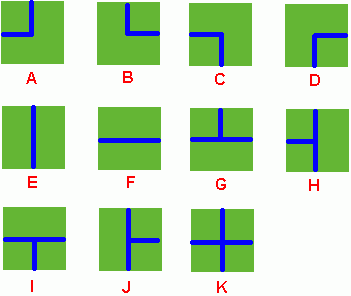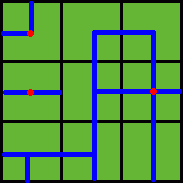
- 淮安团购网美团联盟网赚版 v5.7
- 在PHP中全面阻止SQL注入式攻击之一
- PHP的FTP学习(四)
- 写一个用户在线显示的程序
- php-汉字拼音首字母工具类
- php设计模式 — 工厂方法模式(多态性工厂模式) (虚拟构造子模式)
- PHP 5.0对象模型深度探索之起步
- sql语句删除数据表重复字段的方法
- PHP的面向对象编程:开发大型PHP项目的方法(一)
- php生成EXCEL的东东
- 用PHP实现POP3邮件的解码(一)
- PHP自定义函数返回多个值
- DokuWiki整合Zentao的用户授权及分组体系
- php获取数组的键值
- PHP基础示例:用正则表达式修改配置信息
- 解決imagick在多线程运行时导致CPU暴增到100%的方法
- LotusPhp中配置文件组件LtConfig详解
- 4项技巧使你不再为PHP中文编码苦恼
- PHP创建和使用session cookie变量
- 谈谈favicon和他带来的问题
- 单件模式结合命令链模式
- 建立文件交换功能的脚本(一)
- svn报错
- 在ZendStudio 中开启PHP 5.2.x 环境的远程调试功能
- 利用PHP程序设定防止MySQL注入或HTML表单滥用
- [视频教程]PHP_LAMP兄弟连之PHP 7.2.类的声明使用
- 掌握常见的几种页面静态化的方法
- PHP与Javascript的两种交互方式
- Laravel
- Yii的学习(5)--Active Record的关联
HDU 1198 Farm Irrigation 两种方法(dfs,并查集)
作者:佚名 php网站开发编辑:admin 更新时间:2022-07-23
HDU 1198 Farm Irrigation 两种方法(dfs,并查集)
Figure 1 Benny has a map of his farm, which is an array of marks denoting the distribution of water pipes over the whole farm. For example, if he has a mapADCFJKIHEthen the water pipes are distributed like
Figure 2 Several wellsprings are found in the center of some squares, so water can flow along the pipes from one square to another. If water flow crosses one square, the whole farm land in this square is irrigated and will have a good harvest in autumn.Now Benny wants to know at least how many wellsprings should be found to have the whole farm land irrigated. Can you help him?Note: In the above example, at least 3 wellsprings are needed, as those red points in Figure 2 show.InputThere are several test cases! In each test case, the first line contains 2 integers M and N, then M lines follow. In each of these lines, there are N characters, in the range of 'A' to 'K', denoting the type of water pipe over the corresponding square. A negative M or N denotes the end of input, else you can assume 1 <= M, N <= 50.OutputFor each test case, output in one line the least number of wellsprings needed.Sample Input2 2DKHF3 3ADCFJKIHE-1 -1Sample Output23AuthorZHENG, LuSourceZhejiang University Local Contest 2005

http://acm.hdu.edu.cn/showPRoblem.php?pid=1198
Farm IrrigationTime Limit: 2000/1000 MS (java/Others)Memory Limit: 65536/32768 K (Java/Others)Total Submission(s): 4991Accepted Submission(s): 2143
Problem DescriptionBenny has a spacious farm land to irrigate. The farm land is a rectangle, and is divided into a lot of samll squares. Water pipes are placed in these squares. Different square has a different type of pipe. There are 11 types of pipes, which is marked from A to K, as Figure 1 shows.

题目大意:给定农田的水管的走向,如果两块农田有水管能够互相连通,则它们是相连的,水流能通过两块农田。要你求出最少需要挖多少口井(水井在每块农田的正中央),才能使所有农田都被灌溉。根据上图例子,需要3口水井就能将所有农田都被灌溉。
分析:这道题有两种方法可以做,第一种是简单dfs,第二种是并查集,dfs如果不懂的同学就要去普及搜索知识了。并查集的话同样,求连通区域的个数,如果两块农田连通,则它们在一个等价类中,最后求等价类个数。
dfs方法实现如下,首先要对11个农田状态进行标记,个人标记的方法各不相同,可以使用二维数组存储,这里我用结构体表示更为直观:

1 #include <iostream> 2 #include <cstdio> 3 #include <cstring> 4 using namespace std; 5 6 struct farm 7 { 8 bool left,right,top,bottom; 9 farm()10 {11 left=right=top=bottom=false;12 }13 }FM[13];14 char mp[55][55];15 bool vis[55][55];16 int n, m;17 void init()18 {19 FM[0].left=FM[0].top=true;20 FM[1].right=FM[1].top=true;21 FM[2].left=FM[2].bottom=true;22 FM[3].right=FM[3].bottom=true;23 FM[4].top=FM[4].bottom=true;24 FM[5].left=FM[5].right=true;25 FM[6].left=FM[6].right=FM[6].top=true;26 FM[7].left=FM[7].top=FM[7].bottom=true;27 FM[8].left=FM[8].right=FM[8].bottom=true;28 FM[9].top=FM[9].right=FM[9].bottom=true;29 FM[10].left=FM[10].right=FM[10].top=FM[10].bottom=true;30 }31 void dfs(int x, int y)32 {33 vis[x][y] = true;34 int c = mp[x][y]-'A';35 if(x-1>=0 && FM[c].top && FM[mp[x-1][y]-'A'].bottom && !vis[x-1][y])36 dfs(x-1, y);37 if(y-1>=0 && FM[c].left && FM[mp[x][y-1]-'A'].right && !vis[x][y-1])38 dfs(x, y-1);39 if(x+1 < m && FM[c].bottom && FM[mp[x+1][y]-'A'].top && !vis[x+1][y])40 dfs(x+1, y);41 if(y+1 < n && FM[c].right && FM[mp[x][y+1]-'A'].left && !vis[x][y+1])42 dfs(x, y+1);43 }44 int main()45 {46 init();47 while(cin >> m >> n)48 {49 if(m<0 || n<0) break;50 for(int i = 0; i < m; i++)51 for(int j = 0; j < n; j++)52 cin >> mp[i][j];53 memset(vis, false,sizeof(vis));54 int sum = 0;55 for(int i = 0; i < m; i++)56 for(int j = 0; j < n; j++)57 if(!vis[i][j])58 {59 sum++;60 dfs(i, j);61 }62 printf("%d\n", sum);63 }64 return 0;65 }View Code并查集方法,将二维坐标转化为一维,对每块农田找左、上连通情况,合并等价类,关于等价类更多知识,请读者补充知识:

#include <iostream>#include <cstdio>#include <cstring>using namespace std;int F[3100];char mp[55][55];int m, n;char pipe[11][5] = {"1100", "0110", "1001", "0011", "0101", "1010", "1110", "1101", "1011", "0111", "1111"};int Find(int x){ if(F[x] == -1) return x; return Find(F[x]);}void Union(int x, int y){ int t1 = Find(x); int t2 = Find(y); if(t1 != t2) F[t1] = t2;}int main(){ while(scanf("%d%d", &m, &n)) { if(m<0 || n<0) break; for(int i = 0; i < m; i++) scanf("%s", &mp[i]); memset(F, -1, sizeof(F)); for(int i = 0; i < m; i++) for(int j = 0; j < n; j++) { if(i>0 && pipe[mp[i][j]-'A'][1]=='1' && pipe[mp[i-1][j]-'A'][3]=='1') Union(i*n+j, (i-1)*n+j); if(j>0 && pipe[mp[i][j]-'A'][0]=='1' && pipe[mp[i][j-1]-'A'][2]=='1') Union(i*n+j, i*n+j-1); } int cnt = 0; for(int i = 0; i < m*n; i++) if(F[i] == -1) cnt++; printf("%d\n", cnt); } return 0;}View Code- 上一篇文章: 第十章 日期与时间
- 下一篇文章: PHP初学留神(四)
- 35 PHP视频教程 通过回调函数得到数组交集或
- 用Suhosin加强PHP脚本语言安全性
- 百度ueditor 上传图片后如何设置样式
- PHP获得文件的md5并检验是否被修改
- [视频教程]PHP100视频教程29:PHP模板引擎S
- Memcached深度分析
- Z-BlogPHP 安装出现 (8) Undefined offset
